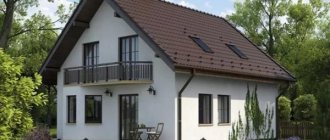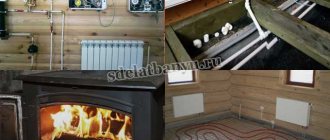If anyone thinks that a garage is just a place to park a car, it’s women. Little do they know that the garage is actually a men's club, where you can not only repair the iron horse, but also receive friends. One problem is that in our climate from October to April the air temperature does not allow much lingering in unheated rooms. Today we will take a closer look at the types of heating and choose the most economical method. Heating a garage and everything you need to know about it is in our material.
A warm, cozy car box is just a home for most car enthusiasts
Self-made dehumidifier
Before starting work, you need to determine how exactly moisture will be extracted from the air.
Desiccant desiccant
They are cut into two parts, and holes are made in the bottom with a hot awl or knitting needle. The upper half is placed in one part of the bottle with the neck turned down, and the cork is also pierced in several places. Apply silicone gel, about 250 grams.
With the second bottle, they carry out other work - they cut off the bottom, put a cooler inside, which blows into the cut hole. A pressure unit is made at a distance of 7 or 10 centimeters from the bottom, after which the structure is placed on a bottle with gel.
All joints are sealed with tape. The cap of the second bottle is removed or replaced with gauze. This ensures free air flow.
The fan forces air masses into the desiccant, and then the air comes out through the gauze. If the gel loses its absorbent properties over time, simply dry it in the oven for about 3 hours. Thus, air dehumidification occurs without noise and is quite effective.
Condensing dryer
You will need an old refrigerator, screws and sealant, a simple heater, computer coolers, plexiglass and a rubber hose. Remove the door from the refrigerator, setting the plexiglass sheet to size, keeping the thickness to 3 mm.
Fans are mounted in such a panel, retreating from the edges by 30-40 centimeters. The fan grilles are treated with sealant and fixed with self-tapping screws. This will be the supply part of the system, pushing air inside the refrigerator.
The top of the plate is equipped with several small holes to allow cooled, dry air to escape. The area of all openings must be equal to the size of the fan.
Alternatively, the air can be removed by a second fan, which is placed on top. This will dry the air by 8%, reducing the temperature by 5 degrees.
This model can be further improved by adding a heater. It is mounted at the top of the device or on plexiglass
It is important to make an intersection of the air flows entering through the fan inside and the dried air flowing out
Although outwardly such a dehumidifier for the basement does not look attractive, it significantly saves the cost of purchasing ready-made devices and effectively removes moisture from the basement.
Western European experience
If you type the phrase “garage heating” in the search and look at pictures on English-language sites, you will not find any wood-burning or oil-fired stoves in Western European garages. How do local motorists warm themselves:
- electric portable heaters;
- infrared hanging heaters;
- air heating units (heaters).
We have already discussed the first 2 options above. The third method is also far from new: water heated in the boiler passes through a radiator, blown by a powerful axial fan. Ideally, the unit is suspended from the ceiling and distributes hot air throughout the room.
The advantages of this option are compactness, heating speed and the possibility of air conditioning in the summer (cooled water is sent to the radiator instead of heated water).
Heater made from a car radiator
There is one downside - increased costs for equipment, because the coolant must be heated in the boiler and supplied through pipes to the heater. But if the garage is attached to a private house, then the problem is easily solved by connecting the radiator to the building’s water heating system.
Watch this video on YouTube
Ready-made dehumidifiers
Basement dehumidification is based on increasing the dryness of the air and drawing moisture out of the walls. Typically these are fans that circulate raw air to the evaporator. There it cools and dehydrates. The flow passes through the condenser, which is accompanied by heating. And the output is dry and warm air, filling the room.
Air exchange
The most significant characteristic of the device, on which the efficiency of the equipment depends. Determines the number of cubic meters of surface to be drained per hour of operation. The air exchange in the room should exceed the size of the room several times. Only under this condition will an acceptable result be achieved.
Operating temperature
A condensation type dryer is used at 15 degrees Celsius. If the temperature is lower, about 10 degrees, then the device will spend too much energy on defrosting and heating the air. In this mode, it would be optimal to use an adsorbing type of device.
Energy costs
The operation of the device requires prolonged consumption of electricity, which will increase electricity bills and cause certain loads on the electrical wiring. Specifications for each unit may vary depending on the model of the device and its manufacturer.
Condensate collection container
The container for collecting moisture is designed for comfortable use of the device; the larger it is, the less often you will need to drain it. If there is a sewer drain nearby, then you can lower the drainage pipe directly into it, removing moisture from the tank directly.
In order to save money on purchasing ready-made equipment and, if you want to gain new experience in developing devices, you can make dehumidifiers yourself.
We recommend to buy
Step-by-step instructions for making a brick stove for a garage
A brick oven for a garage is a compact heat generator. To build a medium-sized brick stove you will need: - Bricks - 300 pieces. - Stove door. — Grate. - Grate door. - Valve. — Cast iron stove.
For the product they take ordinary brick. To assemble the firebox, refractory bricks are taken. Silicate samples in the manufacture of fireboxes are a useless element. It is better to line the firebox with fireclay bricks. Was it worth laying the foundation? If the entire system weighs more than half a ton, then definitely. If the mass is less, then there is no need to fill the foundation. In our case, we will pour the foundation.
Brick laying is carried out according to the existing order. First, lay out the starting row - the base. Then, according to the order, they lay out row by row. We place the necessary iron parts of the structure in pre-designated places. The parts are attached with ordinary wire, which is then laid in rows of bricks. On top, if necessary, you can install a stove for heating food. At the end, according to the order, we lay out the chimney.
Next, we make the seams on the walls. An important point is drying the finished product. It is done gradually. In various sections of the firebox, light garbage, paper, newspaper, and wood chips are burned for about half an hour. This way the stove gradually dries out from the inside. When there are no wet marks left outside, and there is no condensation on steel products, you can start burning wood. Simple conclusions arise. You need a garage oven made of bricks in case of constant activity (for example, a car service).
To maintain a constant temperature, the easiest mode. It is enough to throw in a few sticks of firewood or add coal. Oxygen is burned into the room in a minimal amount. The cost of such a design, when made by hand, is low. The temperature in the box remains stable for a long time. As a result of the efforts, a wood-burning stove for a brick garage was obtained.
Creating a ventilation system in the cellar
The most popular scheme is considered to be natural ventilation of a cellar in a garage: to implement it, it is enough to install pipes that are used for air supply and exhaust. The design works due to the difference in atmospheric temperature conditions, however, when arranging it, you need to remember the difficulties:
- In summer, the temperature difference practically disappears and the air flow stops.
- In winter, the exhaust pipe can become clogged with ice and snow, so it needs to be warmed up.
A more effective option is a forced system: in it the movement of air is carried out using a fan and a pair of pipes. Before making ventilation in the cellar under the garage, you should calculate the power of the equipment that will need to be purchased: for this you need to determine the area of the garage and the parameters of the basement.
Basement heating Library
There is a basement in almost every apartment and private building. It is used for different purposes: laying pipelines and heating equipment, storing agricultural products, and converting it into a living space. Shops and offices are often located on the ground floors: rent here is cheaper.
Basement of a private house
However, if we are talking about the basement of a country house, then fresh harvests and pickles, as well as unnecessary things, are usually stored in it. To prevent anything from spoiling or rotting, you need to take care of the heating system in the basement.
The choice of equipment largely depends on the location of the basement: for a summer house and a garage you need to select different options. It’s worth starting from how much thermal energy you need for heating. Along with the basement heating system, it is necessary to organize forced ventilation, since there are no windows in the underground for natural air exchange.
Storage of agricultural products
To organize the storage of potatoes, carrots, beets and other crops in the basements of a private house or garage, as a rule, additional heating of the basement is not required - usually the proximity to the living rooms above is sufficient. Low temperatures are not scary, but the main thing here is not to let it get below zero.
If the underground freezes, heating the basement of a private house is necessary, otherwise the products will freeze. It can be organized in several ways, the most justified is connecting heat guns (fan heaters) or infrared heaters.
Bath, sauna, swimming pool
To create an additional source of heat, you can lay a warm floor, preferably a strip floor, it is more unpretentious and lasts a long time.
An electric heated floor is expensive if you use it constantly, but for temporary heating this option will be the best, because it is easy to install.
Isolated room
If you organize additional living space in the basement of a private house, you can use a stove or boiler to heat it. It makes sense to install the boiler not in one basement, but in the whole house; simply lay an additional pipe in the underground with a coolant, for example, water, if water heating is used.
Calculation of basement heating: a 25 kW boiler is installed to heat 60-180 sq. m area, 25-35 kW – 200-300 sq. m. For rooms up to 200 sq. m. A long-burning stove is also suitable. Heated floors can be used as additional heating.
Why is it necessary?
It makes sense to insulate the garage basement only if the depth is insufficient and the outside temperatures are extremely low. If the basement is at least three meters deep, there is no need to protect the room from the inside from freezing.
Sometimes you just need to insulate the crossbar between the garage and the basement and adjust the ventilation. When setting up a warm cellar, experts advise thinking in advance about what products you plan to store there, and whether you should take care of additional moisture insulation.
Reasons for rising humidity
It is better to eliminate dampness in the basement immediately than to deal with its consequences later. The reasons may be the lack of proper air exchange, ventilation and window openings, moisture absorption by the walls of the room, poor or insufficient waterproofing protection, clogged drainage, abundant flood or groundwater.
Typically, spores of fungal infection and mold are present in all rooms, only they are inactive. But as soon as conditions for their reproduction appear (temperature above 20 degrees Celsius with a humidity of 80%), they begin to cover all accessible surfaces.
To successfully combat such infections, you need the right dehumidifier, which will change the air exchange parameters in the basement and prevent the development of pathogenic bacteria.
Warm, light and flies don't bite
What can drive a man out of a garage? Only cold and hunger. The first one, as it turns out, is not difficult to deal with. You just need to choose the right heating device. And any motorist can install it and operate it competently.
Hunger is more difficult. But, of course, the iron horse will have to remain in splendid isolation if a beautiful wife and lush hot pies await his owner at home
If you have your own experience in arranging a warm car box, share with us in the comments!
What you need to know to make a heated floor system in the basement, stages of work
Back
Any room has its own specifics, and the basement is no exception. Therefore, when you need to arrange heating in it, different ideas come to mind. One of these is heated floors in the basement. It’s worth figuring out how realistic it is to equip it.
Warmth in the basement - the house will be warm too
Basement Features
The floor in the basement of a house cannot be called warm, because it is closest to the soil, even if it is clay, which means it is a priori cool. There are no joists between which thick insulation could be laid
Therefore, it is important to ensure normal heating in the basement so that humidity and dampness do not penetrate the house
Here you can use different techniques. Many people prefer not to install heating in the basement at all, but to limit themselves to insulation and high-quality waterproofing. You should not think that by installing a heated floor in the basement, you can avoid humidity there: if there is no waterproofing, or it is made poorly, no heating will help in this case.
Important! To prevent excess cold and moisture from penetrating into the basement, you need to take care of this at the stage of building the house, otherwise it will be difficult to do anything later
On the ground
The basement may not have floor slabs or concrete screed; in this case, heating will be installed directly on the ground, and in some cases even on clay. This, of course, will require additional materials.
Warm floor in the basement? Why not
It is worth noting that installing a floor directly on the ground without a concrete screed is fraught with subsidence, although this does not always happen and not for everyone. But there is always such a risk, because the pie of such a heating system weighs a lot, which leads to shifts in even the most compacted foundation of earth and clay. Therefore, you need to think carefully before making such a floor.
https://youtube.com/watch?v=oOAgt8umeFI
Installation of a heated floor on the ground in the basement of a house:
- A layer of bulk 15 cm thick is laid on the natural soil and compacted well. Sand and clay are used for embankment.
- Next, crushed stone is poured - 10 cm.
- Expanded polystyrene 7 cm thick is laid on top of the crushed stone.
- Lay a layer of waterproofing.
- Next, pipes or underfloor heating mats are laid. The IR system is not used when arranging basement heating. A concrete screed is poured on top, which must be reinforced.
- Now it’s time for the flooring; the best option is tiles.
Installation of heated floors on the ground
If you decide to install a screed, it must be poured at the stage of laying crushed stone. It can be presented in the following forms:
- Crushed stone is spilled with a liquid solution. Materials for it: sand - 2 parts, cement - 1 part. Mix with water until fluid.
- Pouring the rough screed, the thickness of the concrete layer is up to 7 cm. It is advisable to reinforce the rough screed.
Base heating equipment process
To make a warm floor using slabs or joists on the ground floor of a house, you will need the same materials, only the layers of the cake will be slightly different.
The base can be concrete slabs, screed, or another base on logs. The convenience of installing a heated floor is that subsidence is impossible, and the materials used to install the system and the finish will not be damaged.
Any beginner in the construction business can do this type of arrangement, especially if you use mats with wire for the system. Necessary materials:
- Cement.
- Sand (not clay).
- Bends and fittings for taps, pipes for water heating.
- Electric floor mats, thermostats.
- Floor covering.
- If the base is a slab, then it may need to be sealed and leveled; this also requires materials.
- Materials for waterproofing and insulation.
Waterproofing is a must
The procedure for installing heating on slabs or concrete screed in the basement of a house:
- Place a layer of waterproofing on the slab. Its canvases should overlap and overlap the walls by 10-15 cm.
- Insulation, for example, polystyrene foam or mineral wool of maximum density. This insulation is also placed between the joists of interfloor ceilings, so it is worth purchasing it immediately to insulate the entire house.
- Pipes or mats of the heating system.
- Screed with reinforcement.
- Flooring.
Fixing the heated floor system on the grid
Installation of sheathing
If the insulation used is sheet or roll, it becomes necessary to manufacture sheathing for installation. It is made from metal profiles or wooden sheathing (antibacterial impregnation is required for use in the basement).
The spacing of the beams is most easily determined by the width of the material, especially since this will significantly save costs. Before installing the sheathing, it is also necessary to waterproof the cellar walls. Even an ordinary thick film is suitable for this, the joints of which are well taped. If the room is very humid, it is better to purchase special waterproofing materials. For high-quality protection, at least two layers are used, in the middle of which there is the insulation itself.
Main nuances of the work:
- It is necessary to provide free space between the lining sheet and the insulation for the necessary ventilation of the room. This will ensure a long service life of the structure.
- If you plan to install shelves or racks with wall mounting in the cellar, the frame must be strengthened at the installation sites. This is done using beams of larger cross-section. Be sure to measure the distance so as not to drill into the wall “blindly”.
- For lathing, you can use special metal guide profiles. This will increase the cost of insulation, but this option is very resistant to corrosion (galvanized steel is used), and also gives proper strength to the structure with a relatively low weight.
- Wooden sheathing is much cheaper, because you can use material that was not useful in construction, as well as all available wooden pieces. However, before installation they must be impregnated with special compounds. They “preserve” the wood from damage and also make it less flammable.
Installation of the sheathing can be done using different methods; the easiest way is to do it according to a pre-marked diagram. It must be completed in any case, because before purchasing materials this will have priority. It is necessary to calculate the material with a small margin, especially if you are performing such work for the first time.
Calculation of underground floor heating
Often homeowners do not think about heating basements and basements because they do not use their area as a living area. And in seasonal homes, heating issues are not particularly relevant. However, if you live in a private house in winter, the situation changes dramatically. To organize a heating system, you will need to make some preliminary calculations.
When choosing boiler heating, it is necessary to accurately calculate the area of the room that needs to be heated (this can be either the whole house at once, or just the basement). If the area is large enough (from 500 sq. m.), then the boiler power should be more than 40 kW. When it is necessary to heat only the basement of a private house, then simple equipment with a power of about 25 kW will be sufficient.
When installing a stove, you must first decide on its type: a “potbelly stove”, a brick stove or, possibly, a long-burning stove
When choosing a potbelly stove, you need to take into account that this device can only heat a small cellar or basement of a country house, therefore, if you need to heat a large room, you should pay attention to other types of stoves
The long-burning stove is suitable for an area of up to 200 square meters. m. The required power of such a stove is calculated in exactly the same way as in the case of boiler equipment. A good option would be to install a traditional brick stove, because in this case you don’t have to decide on power. The main thing is to correctly calculate the dimensions of the chimney and arrange the firebox.
If a traditional brick stove was installed in the basement, it is important to remember that its damper should be closed when everything has already burned out and no flame appears on the coals. This will significantly save fuel by saving heat.
If this is not done, the heat emanating from the coals will simply go out into the chimney.
Important information for your safety
The second possible danger after carbon monoxide poisoning is a garage fire. There are always flammable materials here, including the contents of the car's fuel tank. Neglect of safety measures is fraught not only with the loss of your garage and your beloved horse, but also with a serious lawsuit from neighbors in the parking lot.
For these reasons, we consider it useful to remind you of the basic rules:
- use low-flammable or non-flammable materials for the construction and finishing of the garage structure;
- do not store large amounts of fuel and oil in this room;
- make it a rule to smoke outside;
- do not carry household rubbish into the garage, it will become the main “food” for the fire;
- keep a fire extinguisher on hand, one day it will save your garage from fire;
- do not install electric heating systems in damp rooms;
- Do not leave your garage heating boiler unattended.
Think about the fact that it would be a good idea to install the simplest smoke detectors in this room.
Modern technologies make it possible to install such systems and connect them to a mobile phone
Proper air exchange device
For the most competent ventilation device in the garage basement, the following points must be taken into account:
The most effective is the exhaust system, which ensures the circulation of air masses even in summer. When using a fan in a circuit, care should be taken to insulate it and protect the wiring from moisture that forms during the process. If the area of the room is less than 40 square meters, and food is stored inside, it is necessary to install a hood. When choosing equipment, it is important to understand which fan to take: a device that is too powerful consumes more energy, and a model that is too weak does not allow all the moisture to be completely removed.
Ventilation
In addition to insulation work, it is important to organize high-quality ventilation inside the garage basement. After all, a proper ventilation system is the key to long-term storage of food, the absence of mold, mildew, and an unpleasant musty smell. It can be of two types.
| Type of ventilation system | What is needed for an organization? | Installation features |
| Natural | Metal pipe sections | The exhaust pipe should be fixed at the ceiling and brought out at a distance of 50 cm just above the roof. The supply pipe will need to be fixed at a height of 10 cm from the floor, and then taken outside |
| Forced | Electric motor, supply and exhaust pipe | The principle of organization is similar to the natural type of ventilation, but an electric motor must be mounted in the exhaust pipe |
| Combined | Electric motor, supply and exhaust pipe | In the summer, you should use natural ventilation; in winter, use a forced ventilation system |
What is insulated?
Depending on the average annual temperature and precipitation, on finances and the structure of the garage basement, the room needs to be insulated:
Important! Even if there is internal heating, and there is no need for thermal insulation of the walls and ceiling, it is recommended to insulate the floor of the garage basement. After all, the warm air from the artificial air conditioner will rise upward, leaving the floor cold
To insulate the lower surface of the subfloor, it is recommended to use polystyrene foam. This requires:
- deepen the floor by 25-30 centimeters and level the surface;
- lay 10 centimeters of crushed stone around the entire perimeter;
- then cover the crushed stone with sand in half (this will help avoid moisture accumulation);
- then apply a layer of insulation;
- and finally make mesh reinforcement and concrete.
Walls
Regardless of the choice of insulation for basement walls, experts advise first treating them with antifungal solutions (quicklime or copper sulfate). Then carefully seal all seams and cracks.
Mineral or glass wool requires an additional frame so that it does not slide under its own weight. The insulation should be well secured around the entire perimeter of the wall.
Ceiling
It is recommended to insulate the garage ceiling with any suitable material
However, it is further important to hide the thermal insulation with sheets of plasterboard, plastic or plywood. Foam and reflective thermal insulation can be hidden under the cladding
Important! Before insulating the garage ceiling, you need to install all the electrical wiring for lighting, laying the wires in a heat-resistant corrugation
Final works
At the final stage, the walls are finished. In the cellar it does not have any decorative value. The main task is to provide the necessary microclimate for the preservation of food supplies.
Final lining of the cellar with clapboard
If the room is dry, you can line the walls with plywood or wood. In this case, it is imperative to treat the cladding material with an antifungal agent. For a basement with high humidity, lining is more suitable.
Wall insulation is not always required in a garage cellar. It happens that it is enough to insulate only the floor. In this case, conventional lime whitening or painting is used to finish wall surfaces.
How to insulate a cellar, methods of insulation and heating
As a rule, a cellar is used at any time of the year to store food, so the main requirement for its design is to create conditions for maintaining a stable temperature all year round. It is necessary to ensure protection against freezing of the cellar in winter and excessive overheating in summer.
There are various ways to insulate a cellar, and their choice depends on the design of the building itself.
If the location of groundwater on the site does not allow the construction of an underground cellar, you will have to pay more attention to the aspects of cellar insulation, in particular vapor barrier, heat and waterproofing.
How to choose the right way to insulate a cellar with your own hands?
There are several of the most common and popular ways to insulate a cellar with your own hands.
- Insulation with sawdust
- Insulation using glass wool or mineral wool
- Application of foam plastic
- Use of modern insulation materials
Insulating the cellar with sawdust
Sawdust is an easily accessible and cost-effective insulation material that can be easily obtained at any woodworking plant.
The disadvantages of this method include some complexity of the process itself - before you start insulating the cellar with your own hands, you need to waterproof the walls and floor using tar, which must be applied in several layers.
Then the layer of sawdust is compacted so that the thickness of the layer is about 30 centimeters and covered with roofing felt. The resulting structure is covered with a concrete screed, which must also be waterproofed with another layer of roofing felt or bitumen.
Insulation with mineral wool
Mineral wool has excellent technical characteristics and provides a sustainable result, but it is quite expensive and requires careful attention to vapor and waterproofing.
Advantages of do-it-yourself cellar insulation with polystyrene foam
Insulating a cellar with your own hands using polystyrene foam has many advantages. This material is affordable, has excellent thermal insulation properties, is lightweight and resistant to mold.
The disadvantages include its easy flammability, which leads to an unstable fire situation, and the ability to emit an unpleasant odor when heated.
Therefore, it is still worth choosing a more environmentally friendly material for insulating residential premises.
How important is it to properly organize cellar heating?
A properly designed cellar should be heated using heat from the soil, which is accumulated by the surface layers of the soil during the warm season. How effective this process will be depends on many factors:
- the presence or absence of a ventilation system;
- groundwater level;
- materials used to waterproof the cellar.
It is known that at a depth of 3–4 meters, fluctuations in the average annual temperature are insignificant and range from 5–10 degrees. Therefore, the depth at which the cellar is built is critical to ensure a stable temperature inside the cellar.
This is especially true for cellars that do not have any buildings above them. Heating a cellar located under a building where people constantly live is a simpler task, since alternative heating methods can be used and controlled.
Natural and electric method of heating the cellar
- naturally;
- using electricity.
The most preferable and safe heating method is natural, due to the accumulative effect of the soil.
Using electric heaters to maintain the desired temperature in the cellar without good insulation can require significant energy costs.
And in the case of cellars on personal plots and dachas, where in winter there is often no electricity, this heating method is completely impossible.
Electric cellar heating is optimal for use in urban environments, where there are usually no power outages. But it is worth remembering that without good insulation of the cellar, electricity costs will be significant.
How to make a potbelly stove during mining
It is not always practical to have a supply of firewood in the utility room. There is a lot of used oil in car workshops. Having an oil-powered potbelly stove on hand is a big deal. You will receive free heat, compared to firewood, which you need to buy and pay for a car to bring firewood.
Testing stoves have general principles of operation. The small chamber is filled with used oil. The oil is set on fire. Bring it to a boil. Oil vapor rises through the pipe. Mixes with oxygen. In the second compartment, oil vapors are burned. According to the materials, the upper chamber of the furnace and the pipe should be as heat-resistant as possible. They account for the highest temperatures. A large-diameter pipe is used as the basis for the mining stove.
There are pipes with a diameter greater than 30 cm. They are well suited for these purposes. The wall thickness will be as follows. Lower chamber from 4 mm. Upper chamber from 6 mm. Cameras are made of arbitrary height. To transition between the chambers, take a good boiler pipe with a diameter of 100 mm or more with thick walls. This pipe will hold the upper chamber on itself. After making the stove, it is coated with heat-resistant paint.
The furnace for the garage being worked on is not described in detail here. There are many descriptions on the Internet. We have only indicated general points.
Installation of heated floors in the basement
Having a heated floor in a living space will be an excellent solution for creating a comfortable environment. Often, heated floors are installed even when the house has stove heating, since cold air masses that arise during ventilation of the room pass through the floor.
It must be taken into account that when installing a warm one, special attention must be paid to thermal insulation and waterproofing of the foundation base. It is recommended to use a combined solution as insulation - mineral wool and expanded polystyrene
Installation of an additional waterproofing layer is necessary if the area has a high groundwater level or there is a possibility of seasonal flooding of the basement.
Installation options for heated floors. Click to enlarge.
Which heating method to choose
Heating a basement or cellar is a rather complicated issue. Here it is necessary to approach the issue of choosing the type of heating of the room as responsibly as possible, based on the wishes and requirements of the owner. For example, if you need to heat the basement in a seasonal home (that is, during the cold spring and autumn months), then installing a simple heater will be enough.
On the other hand, if you plan to turn the basement of a country house into a full-fledged living space, then it is necessary to arrange more efficient heating. The best option in this case seems to be installing a furnace or boiler. It is worth noting that for the installation of a gas boiler it is necessary to allocate a separate room, and its operation must be coordinated with the relevant services.
Basements in an apartment building have a variety of functions. It all depends on the quality of the structure and the location of the central communications, thanks to which water and heat are supplied to the apartments.
Most often, the basement is the property of the residents of this house, and can be equipped for organizing shops or cafes. Recently, it has become popular to organize gyms in basements, but for various types of events it is necessary to think carefully and qualitatively, since air masses naturally do not circulate very well.
It is characterized by high air humidity, which can negatively affect human health. For this reason, various fungal colonies and mold will begin to appear on the walls of the room, which are quite difficult to get rid of.
Advantages and disadvantages of a basement
The main advantage of a basement in an apartment building is the concentration of all necessary communications for functional work. From the basement it is carried out through ventilation ducts, which are located in each apartment.
There is also a central water supply pipe and heating pipes. As a rule, flow meters are installed on such pipes to monitor the total flow of the entire house and each resident individually. The basement also houses the central sewer system, to which all apartments in the building are connected.
The basement can be used as a storage room, but this is only if a certain space is provided there for such purposes. Previously, the basements were used as bomb shelters. Today there are still some basements that have benches or places to rest.
The downside of the basement is the dampness and mustiness of the air due to poor ventilation and lack of natural light.
Advice. To effectively use the basement, it is necessary to ensure high-quality ventilation and waterproofing.
Conducting communications
It is better to conduct pipelines, power cables, and other communications into the basement before insulation.
The cables must be pulled into a protective corrugated sleeve. Ventilation pipes are fixed to the walls or ceiling slab, ensuring the tightness of the passage areas.
After fixing the heat insulator, it is not recommended to lay communications.
Thermal insulation of the caisson
We are talking about separate storage facilities that are built on the territory of the plots for the subsequent storage of vegetables and preservation. To protect this building from frost, it is recommended to do the following:
- Carry out reliable work to insulate the room from the cold outside (this requires the use of dense soil).
- Create high-quality waterproofing, since moisture is often the main cause of freezing.
- Reliably protect internal structural elements from penetration of cold air through the walls.
- Also, if necessary, a special vestibule is created at the entrance, which contains a thermal insulating air cushion.
Previously, we looked at how to insulate a ceiling in a cellar, which is directly related to the heated building. It should also be clarified that when improving the caisson, it is necessary to do the same series of works, but choose denser materials for this.
Important. Gardeners and vegetable gardeners are often faced with the question of whether it is necessary to insulate cellar walls and other structural elements. Here an allowance should be made for the climatic conditions in the region, as well as the purpose of the storage facility. If it is necessary to maintain a comfortable temperature, thermal insulation is necessary. If low temperatures are required, then internal insulation is not always advisable.











